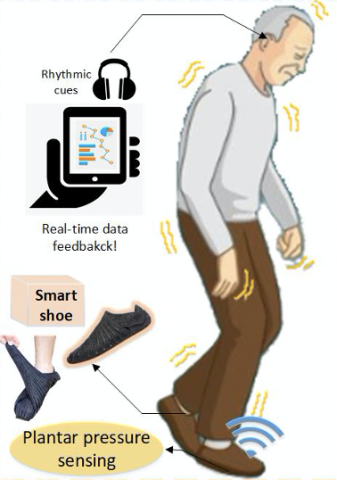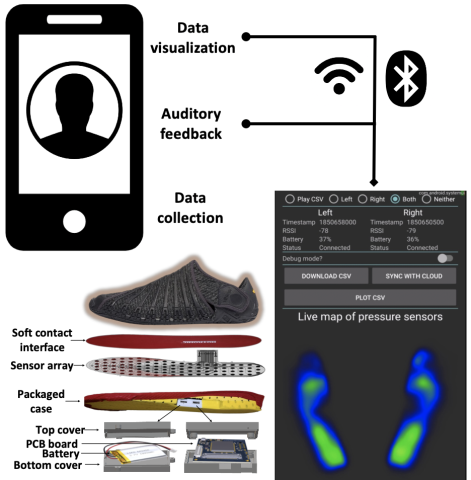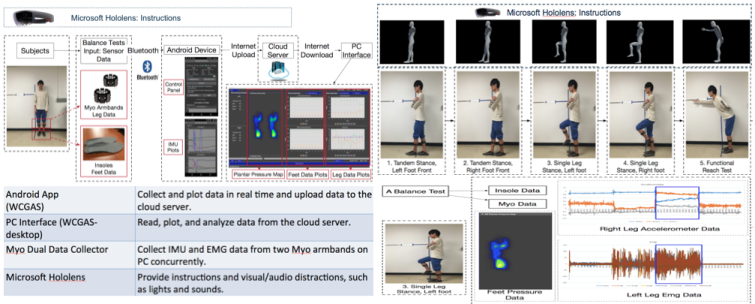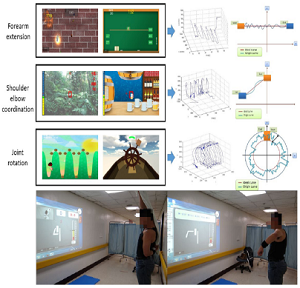AI-based Sensing and Computing System Design to Achieve Just-in-time and Interactive Physical Rehabilitation
In recent years, using inexpensive wearable sensors and mobile technologies (mHealth technologies), in home-based rehabilitation, have demonstrated effectiveness and improved quality of life The overarching goal of this project is to develop and validate a new closed-loop mHealth technology, namely media-instrumented gait training, to facilitate the self-management capacity of long-term home rehabilitation for improvement of gait anomalies and balance, and decreased fall risks among people with neurological disorder. This novel wearable media-instrumented gait sensing training system is capable of guiding gait rehabilitation via rhythmic auditory stimulation and quantifying gait performance, by utilizing a user-centric biofeedback and just-in-time auditory cueing system to improve patient’s functional mobility.
A person’s walk (or “gait”) is a process which involves a repetitious sequence of limb motion to move the body while simultaneously maintaining stability. Gait analysis provides a method to characterize this process. Sensing from foot, important information about human gait, postures of activities, and walking trajectory could be obtained, which could contribute to applications such as healthcare, worker safety, and indoor localization. In this research, an innovative wearable system—Wearable Gait Lab was designed to extract gait, balance, and body posture out of plantar pressure and foot motion from real-time streaming sensor data, enable objective identification of risk factors throughout the day and during a variety of natural activities.
Quantitative Statistical Support for Human Balance Tests (Clinical Collaborators: Ms. Miriam Pekarek at Ohio Living Breckenridge Village and Dr. Elizabeth Madigan)
One-third to one-half of the population over age 65 reports some difficulties with balance or ambulation, which occur more likely on patients with neurological or musculoskeletal disorders. Thus clinicians implement lab-based balance tests to evaluate the function of the vestibular system in the inner ear and identify balance problem sources for the patients. However, classic balance tests use qualitative, semi-subjective standards based on clinicians’ personal judgment, and these tests confined in traditional gait lab environment may lead to environmental bias concerns and cannot reflect patients’ natural behaviors in their used environment. The developed system is evaluated with standard balance tests (Limits of Stability, Sit-To-Stand, and Rhythmic Weight Shift), whereas the data collected are analyzed with data mining techniques to verify the reliability of the designated process. Certain parameters are computed such as Center of Gravity (COG), weight transfer time, and sway velocities. This system provides adequate data for balance ability analysis and simplifies the scoring processes in balance tests. The results show that the system is informational and reliable in the process of determining balance status during tests with additional advantages in high portability and efficient review communications
This research was funded by the Technology Validation and Start Fund (TVSF), funded by the Ohio Third Frontier and UARF I-Corps Sites Program: Fast Forward Medical Innovationsthe and the National Institutes of Health under Award Number 5R01NS040547.
Publications: [J38, J28, J16]
Frozen Shoulder Rehabilitation using Virtual Reality Games [J06]
Frozen shoulder, or adhesive capsulitis, is a condition caused by impaired soft tissues and the articular capsule of the shoulder. It commonly occurs in people aged 40 to 65 years, and it’s more likely to appear in females than in males.1 Frozen shoulder is characterized by painful and limited active and passive range of motion. The main treatment involves proper shoulder exercises and joint mobilization to break up adhesions at the joint capsules and improve joint mobility and functions. However, due to a lack of persistence, not all patients complete rehabilitation. To address this, we created a virtual reality game-based treatment system that encourages patients to participate in regular rehabilitation. Using our system, patients can inquire freely about their rehabilitation progress through real-time sensing and game-based feedback. Six progressive and hierarchical training tasks make each training step adjustable based on the patient’s physical condition.
Our frozen shoulder rehabilitation system jointly developed with the physical medicine and rehabilitation department at Taipei Veterans General Hospital has been listed as a standard medical instrument and reimbursable service by the Taiwan National Health Insurance Administration.




